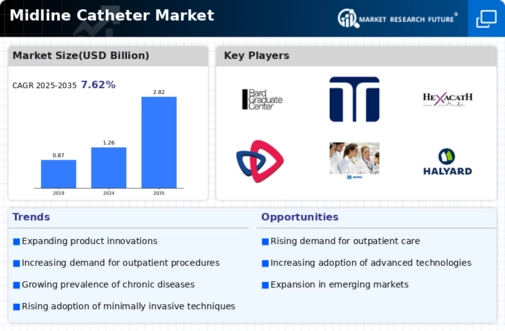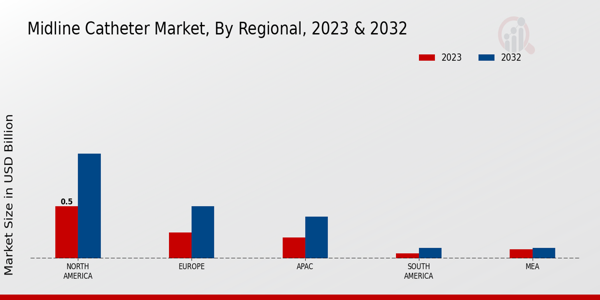Growing Aging Population
The aging population worldwide is a crucial driver of the Global Midline Catheter Market Industry. Older adults often require more medical interventions, leading to an increased need for effective vascular access solutions. Midline catheters are particularly advantageous for this demographic, as they can be used for extended periods without the complications associated with traditional intravenous methods. As the global population aged 65 and older continues to rise, healthcare systems are likely to adapt by incorporating more midline catheters into their protocols. This demographic shift is expected to contribute significantly to the market's growth trajectory in the coming years.
Market Growth Projections
The Global Midline Catheter Market Industry is poised for substantial growth, with projections indicating a market size of 1.26 USD Billion in 2024 and an anticipated increase to 2.82 USD Billion by 2035. This growth trajectory suggests a compound annual growth rate of 7.6% from 2025 to 2035. Such figures reflect the increasing recognition of midline catheters as a viable option for long-term vascular access, driven by factors such as technological advancements, rising chronic disease prevalence, and an aging population. These metrics highlight the potential for sustained expansion within the market.
Regulatory Support and Guidelines
Regulatory bodies are increasingly recognizing the importance of midline catheters in clinical practice, which is positively impacting the Global Midline Catheter Market Industry. Guidelines from health authorities emphasize the safe use of midline catheters, promoting their adoption in various healthcare settings. This regulatory support not only enhances the credibility of midline catheters but also encourages manufacturers to innovate and improve their products. As healthcare providers align with these guidelines, the market is likely to see accelerated growth, fostering a more robust environment for midline catheter utilization.
Increasing Prevalence of Chronic Diseases
The Global Midline Catheter Market Industry is significantly influenced by the rising prevalence of chronic diseases such as diabetes, cancer, and cardiovascular disorders. As these conditions necessitate frequent medical interventions, the demand for reliable vascular access solutions is surging. Midline catheters, which offer a balance between peripheral and central lines, are becoming increasingly favored for their versatility in long-term treatments. This growing patient population is anticipated to drive the market's growth, with projections indicating a compound annual growth rate of 7.6% from 2025 to 2035. This trend underscores the critical role of midline catheters in modern healthcare.
Rising Demand for Long-Term Vascular Access
The Global Midline Catheter Market Industry experiences an increasing demand for long-term vascular access solutions. Healthcare providers are increasingly recognizing the advantages of midline catheters, which are designed for patients requiring extended intravenous therapy. This trend is particularly evident in chronic disease management, where patients may need prolonged treatment. The market is projected to reach 1.26 USD Billion in 2024, reflecting a growing preference for midline catheters over traditional peripheral lines. This shift is likely driven by the need for reduced complications and improved patient comfort, suggesting a robust future for the Global Midline Catheter Market Industry.
Technological Advancements in Catheter Design
Innovations in catheter design are propelling the Global Midline Catheter Market Industry forward. Recent advancements include the development of catheters with enhanced biocompatibility and reduced risk of thrombosis. These improvements not only increase patient safety but also enhance the overall efficacy of intravenous therapies. For instance, the introduction of catheters with integrated antimicrobial properties has shown promise in minimizing infection rates. As healthcare facilities adopt these advanced technologies, the market is expected to witness substantial growth, potentially reaching 2.82 USD Billion by 2035. This trend indicates a strong correlation between technological innovation and market expansion.












